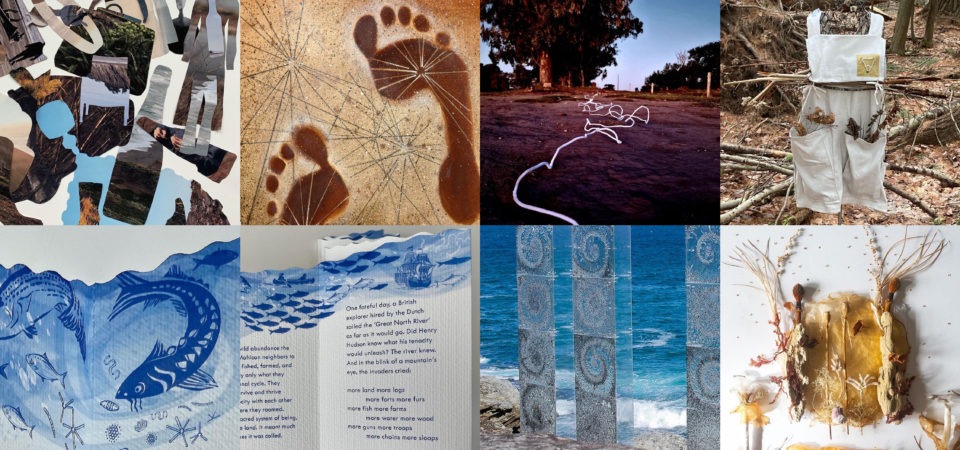– Richard Heinberg
Video Transcript of the lesson here.
Online Exhibition opened March 13, 2023
Featured Artists
Jodie Atherton (US), Christina Conklin (US), Alison Lee Cousland (Australia), Yvonne C Espinoza (US), Ries Faison (US), Diane Farris (US), Deborah Kennedy (US), Michele Guieu (US), Rosalind Lowry (Ireland), Peggy Rose (US), Susan Smith (US), Kim Tanzer (US), Marcela Villasenor (US), Karen Viola (US).
This is the 16th What’s Next for Earth online exhibition based on Think Resilience, a free online course written by Richard Heinberg and produced by Post Carbon Institute.
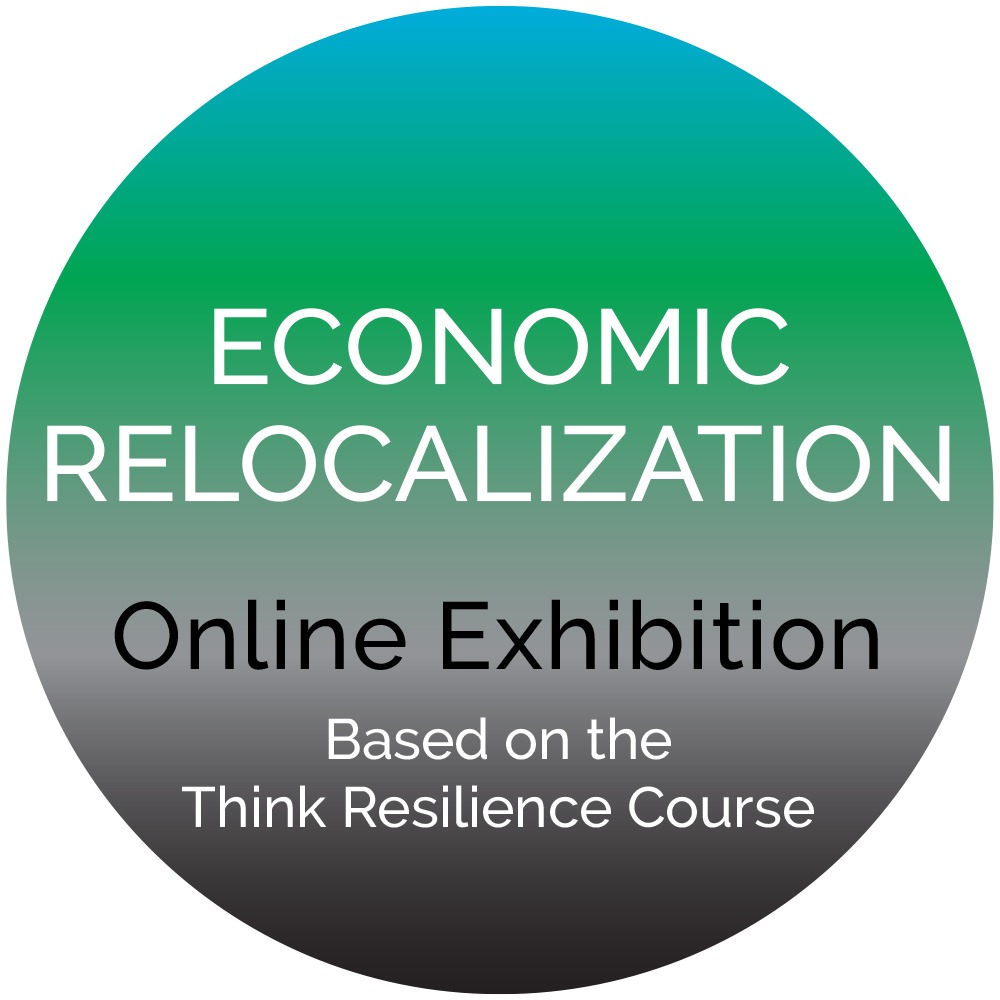 What’s Next for Earth follows the course, one lesson per art call. To respond to this art call, we asked the artists to signup and watch the course. The transcript of the lesson “Economic Relocalization” is here. This exhibition is part of the fifth chapter of the course: Economy and Society.
What’s Next for Earth follows the course, one lesson per art call. To respond to this art call, we asked the artists to signup and watch the course. The transcript of the lesson “Economic Relocalization” is here. This exhibition is part of the fifth chapter of the course: Economy and Society.
“The local challenges created by globalization can be partly countered by economic localization. It starts with communities supporting local business rather than giving subsidies such as tax breaks and free utility hook-ups to large, non-local businesses, as is so often done. In fact, half of all private-sector U.S. jobs are still provided by small businesses, and almost all of these businesses are local. Moreover, local dollars have a multiplier effect—when spent within the regional economy, they increase local wealth, local taxes, jobs, charitable contributions, tourism, and entrepreneurship. Local economic development benefits everyone—except maybe big multinational corporations.”
Exhibition
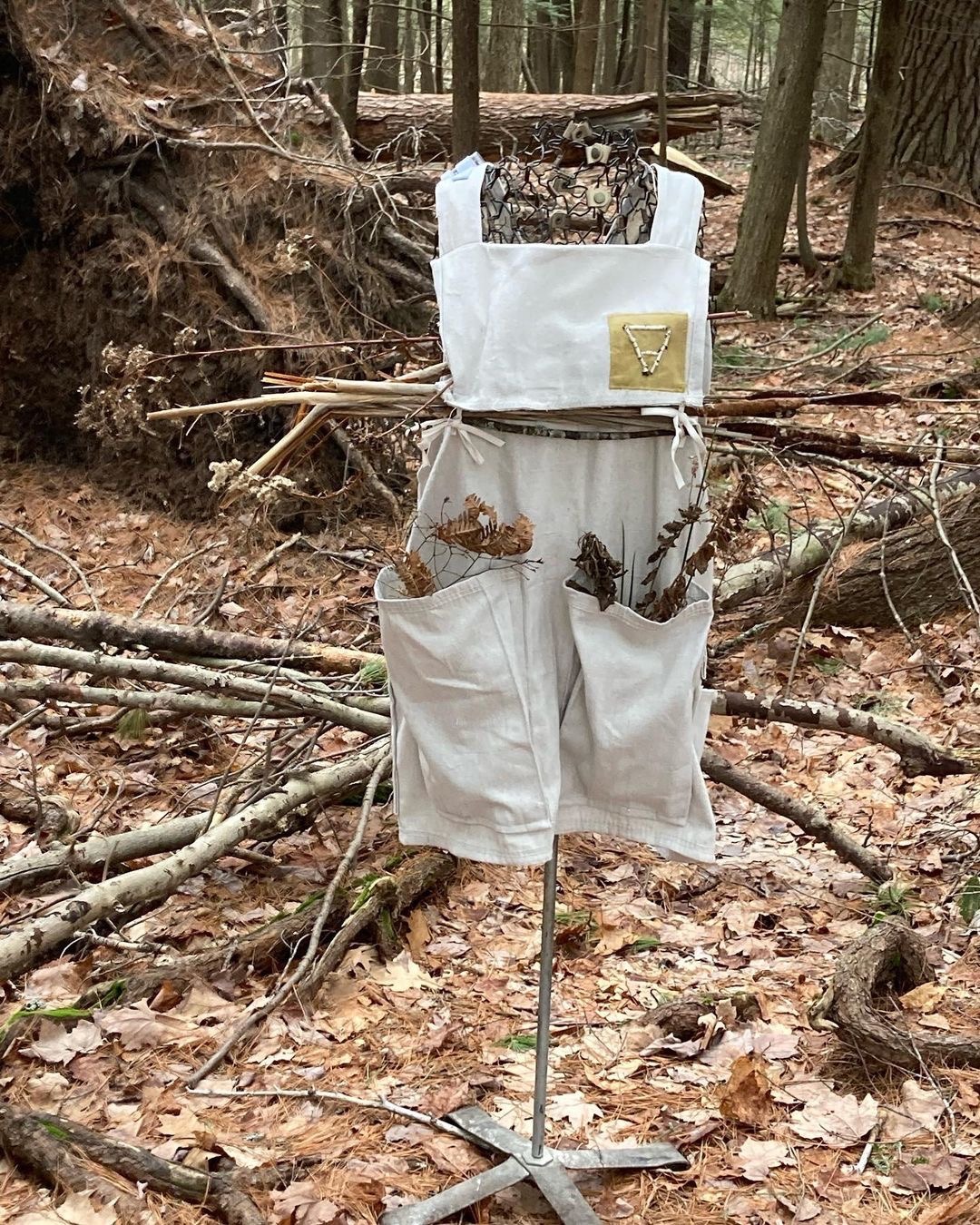
Susan Smith
Tactical Foraging Vest
recycled painting, drop cloths
This vest is designed to support local foraging for edibles and art-ables, plants, pigments and soil-to-soil practices for food and wearables. Calling this “the radical act of staying put.”
This is installed behind my studio in Maine, and worn to forage local edibles and dye plants. I have made a few of these now, encouraging a connection with what lies outside our doors.
When I read the lesson last week, the conclusion stood out “Local economic development benefits everyone—except maybe big multinational corporations. A more local and, therefore, more resilient economy is one in which people feel they have more of a stake in production and distribution as well as consumption; one in which they have more knowledge of where their goods come from and what happens to them at the end of their lifecycle.”
Soil-to-soil sustainability, as well as food sovereignty, are what this piece is really about. I installed it behind the studio, which is also where I work at the University. In just a couple of weeks, this area will be covered with edible fiddlehead ferns. Locals forage these and sell them in the local markets. The pieces are made of recycled painting and drop cloths.
© 2023 Susan Smith
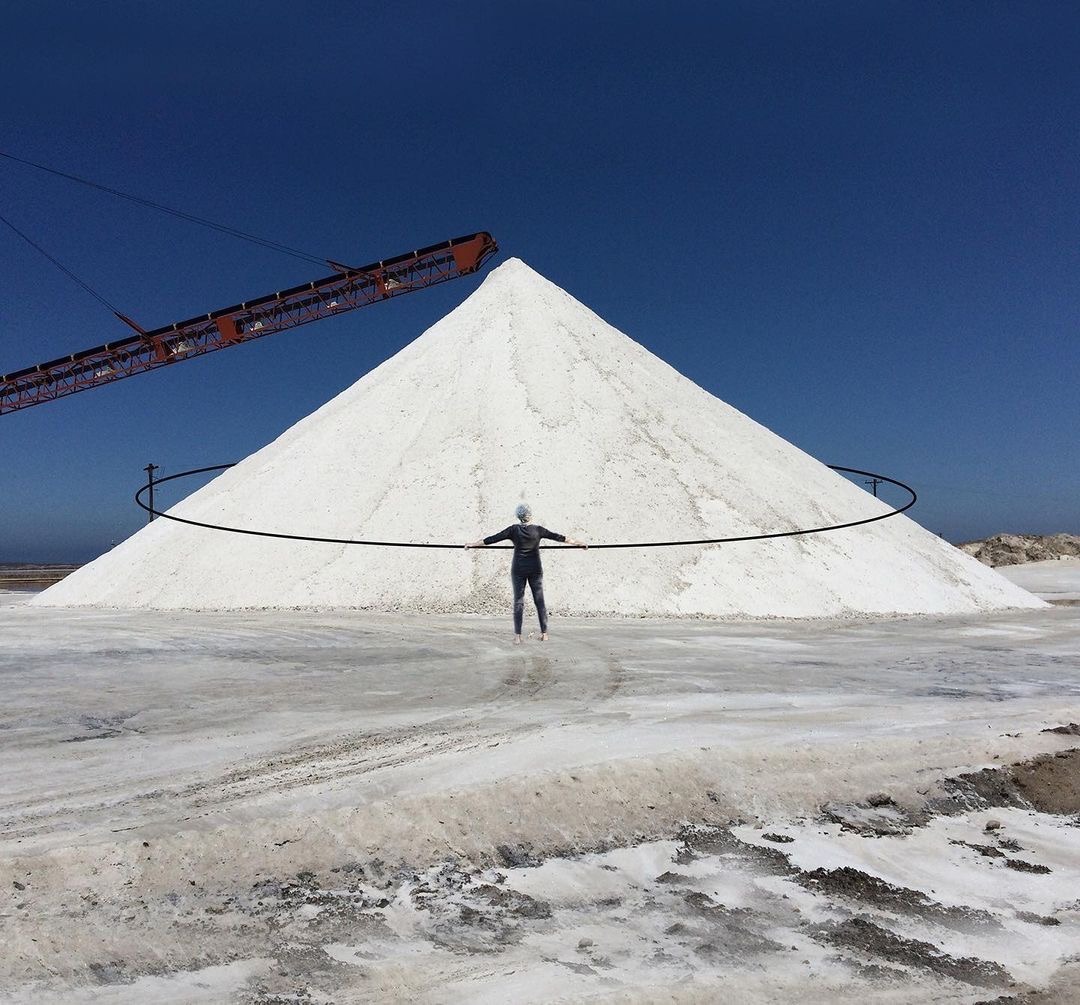
Marcela Villasenor
The Salt
digital collage
2014/2023
The Salt Mines, also known as the South Bay Salt Works, are the 2nd oldest business in San Diego.
The Airport Authority planned to sell the land.
We need to support Regional industries in San Diego like this one. The government wants to shut down this industry that has worked in San Diego for almost a century.
“Nothing fundamentally new has to be invented for this to happen: local economies have deep and ancient roots”’ Richard Heinberg.
© 2023 Marcela Villasenor
Karen Viola
Nursery: The River That Flows Both Ways
The book was created digitally, printed at my home studio with Epson inks on watercolor paper.
It measures 5 x 7 inches when closed, and its accordion format extends it to 50 inches wide.
My artist’s book “Nursery: The River that Flows Both Ways” is a reflection on the biodiversity and history of the Hudson River, which the Munsee Lenape called ‘Muhheakantuck’ (the river that flows both ways).
Knowing the story of our local land where we live and work is the groundwork, literally, for building a local economy. My research took me back to before the internet, before global supply chains, before the Erie Canal, before fur trading, to a time when it was imperative to know where their water and food came from in order to survive. And I realized, this is actually still true on a collective, species level. My prose foregrounds the indigenous wisdom of reciprocity and intimacy with the land and its watershed, and it asks how we might apply this in our lives today.
As Richard Heinberg explains, “A more local and therefore more resilient economy is one in which people feel they have more of a stake in production and distribution as well as consumption; one in which they have more knowledge of where their goods come from and what happens to them at the end of their lifecycle.” I also suggest that we know the basics, starting with where our own water comes from, and where our waste goes. There is no ‘away.’!
© 2023 Karen Viola
Alison Lee Cousland
Economic Relocalization
Kombucha SCOBYs
For the past 2 months, I’ve been exploring the possibility of using Kombucha SCOBYs to make Kombucha fabric/paper.
WHY?
I’m seeking materials that are fine and transparent: malleable, reasonably strong and durable: natural and eco friendly: compostable.
WHY?
I installed an environmental sculpture at Sculpture by the Sea, Bondi in 2011. Titled 11:11, its four transparent pillars overlooking the Pacific Ocean celebrated the opening of the Portal of 11:11:11:11:11:11 ~ The 11th sec/min/hour/day/month/year. (See the last slide.) At the time I wanted to install similar ‘healing’ sculptures on major key lines all over Oz. However after designing, making and installing the first 11:11 sculpture ~ I realised that I needed to find an eco friendly alternative to perspex as the inner structure and resins for the surface ‘orgonite’ spirals.
DISCOVERIES so far.
As a material Kombucha SCOBY is incredibly strong and has such a variety of textures: Can be crinkled and moulded into shape. However in damp and colder weather it goes quite sticky, especially the thinner pieces. Even firmer thicker pieces that dried really well in hot sun and the dehydrator softened in the colder weather. They hardened again in the sun but then tended to go darker.
THINK LOCAL RESOURCES.
Working with local natural materials in my artwork, I know where every element comes from and that at the end of its lifecycle, it can be safely buried without causing any harm to the Earth. And I would like to echo Richard Heinberg’s thoughts on going back to a localized economy: Local economies have deep and ancient roots: They are more resilient and benefit everyone.
© 2023 Alison Lee Cousland
Alison Lee Cousland
Economic Relocalization Art Call. Part 11.
Kombucha SCOBYs and local natural materials
All things in the world are one.
Things that are thought beautiful are considered miraculous and marvellous.
Things that are thought ugly are considered rotten and repulsive.
The truth is that rot and repulsion can transform into miracles and marvels ~ Miracles and marvels into rot and repulsion.
~ Chuang Tzu.
© 2023 Alison Lee Cousland
Alison Lee Cousland
Economic Relocalization Art Call. Part 111.
Kombucha SCOBYs and local natural materials
You have been built up from nothing by the spare parts of the Earth you have consumed, according to a set of instructions hidden in a double helix and small enough to be carried by a sperm. You are recycled butterflies, plants, rocks, streams, firewood, wolf fur, and shark teeth, broken down to their smallest parts and rebuilt into our planet’s most complex living thing.
You are not living on Earth. You are Earth.’ ~ Aubrey Marcus.
Sustainable Resources.
Since installing the 11:11 sculpture in 2011, the ‘notion’ of making similar structures with the potential to transmit healing energy has been on hold. While experimenting with the Kombucha material, the ‘notion’ has surfaced, and I can see how it may be possible now, using ALL natural materials. Like paper and fabric, this Kombucha material can be stitched ~ Which will be the next stage in the making of these (for now) small pieces.
© 2023 Alison Lee Cousland
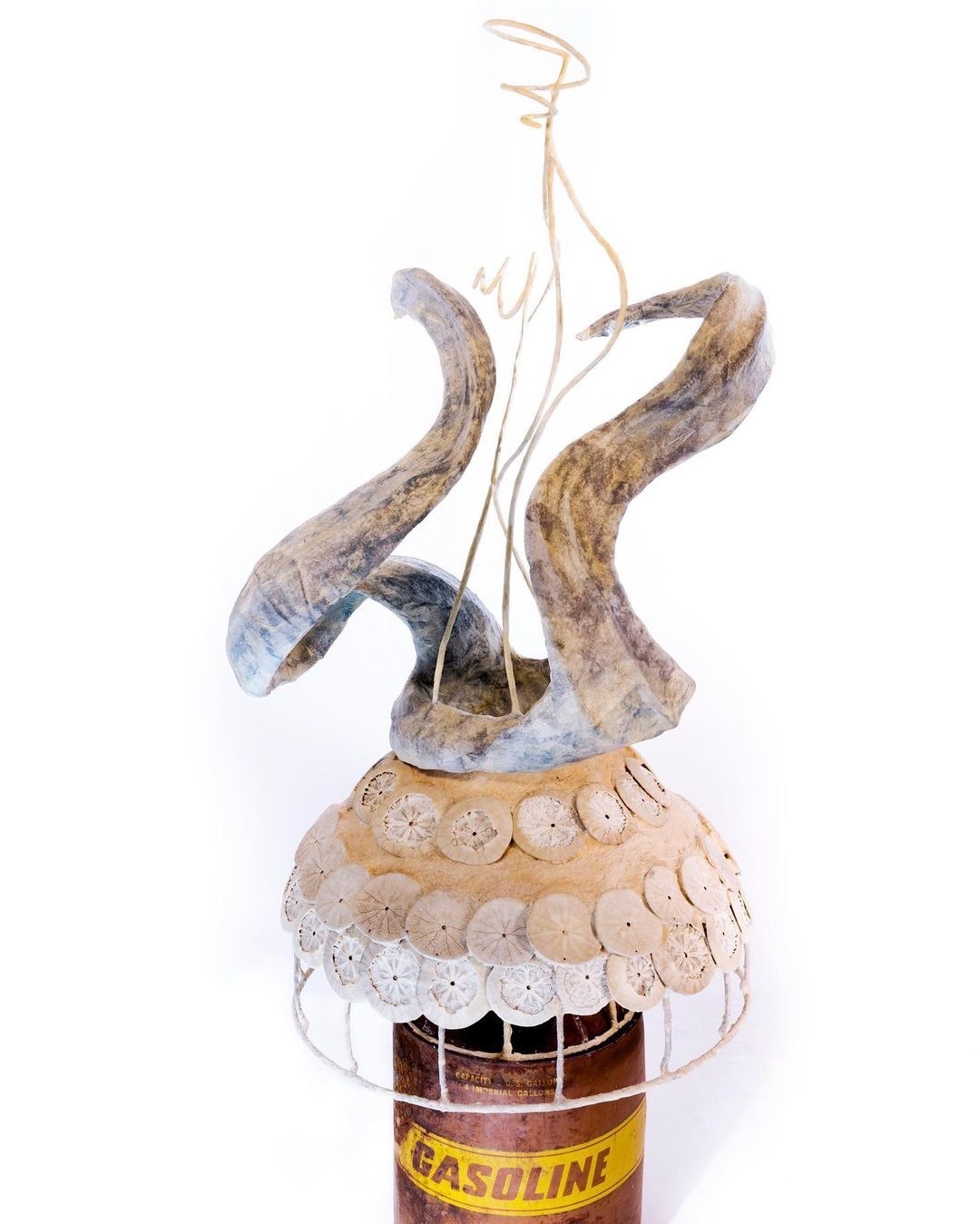
Jodie Atherton
Contemporary Shoreline
Created from welded steel, fiber, paper, seagull-pecked sand dollars, sand, rusty old gas can, and my creativity putting these together to create something new from the individually unwanted objects.
20 x 20 x 51”
Floating down rivers that lead to the ocean,
even in landlocked states in the middle of our country our trash ends up in the ocean…
we are not immune to polluting the seas.
No one is.
A great garbage patch, more plastic than fish.. How is this ok?
The petroleum it takes to bottle water.
To make plastic bottles.
To wrap the bottle with a plastic label.
To wrap the cases of bottles in plastic.
To deliver said water across the country and the world.
All of it to not really even be recycled.
This can be partly countered by economic localization, which helps to make communities more resilient.
What are you doing to reduce your footprint? How are you supporting your local economy? What are you saying yes to? What are you saying no to? what are the pros and cons of your actions?
© 2023 Jodie Atherton
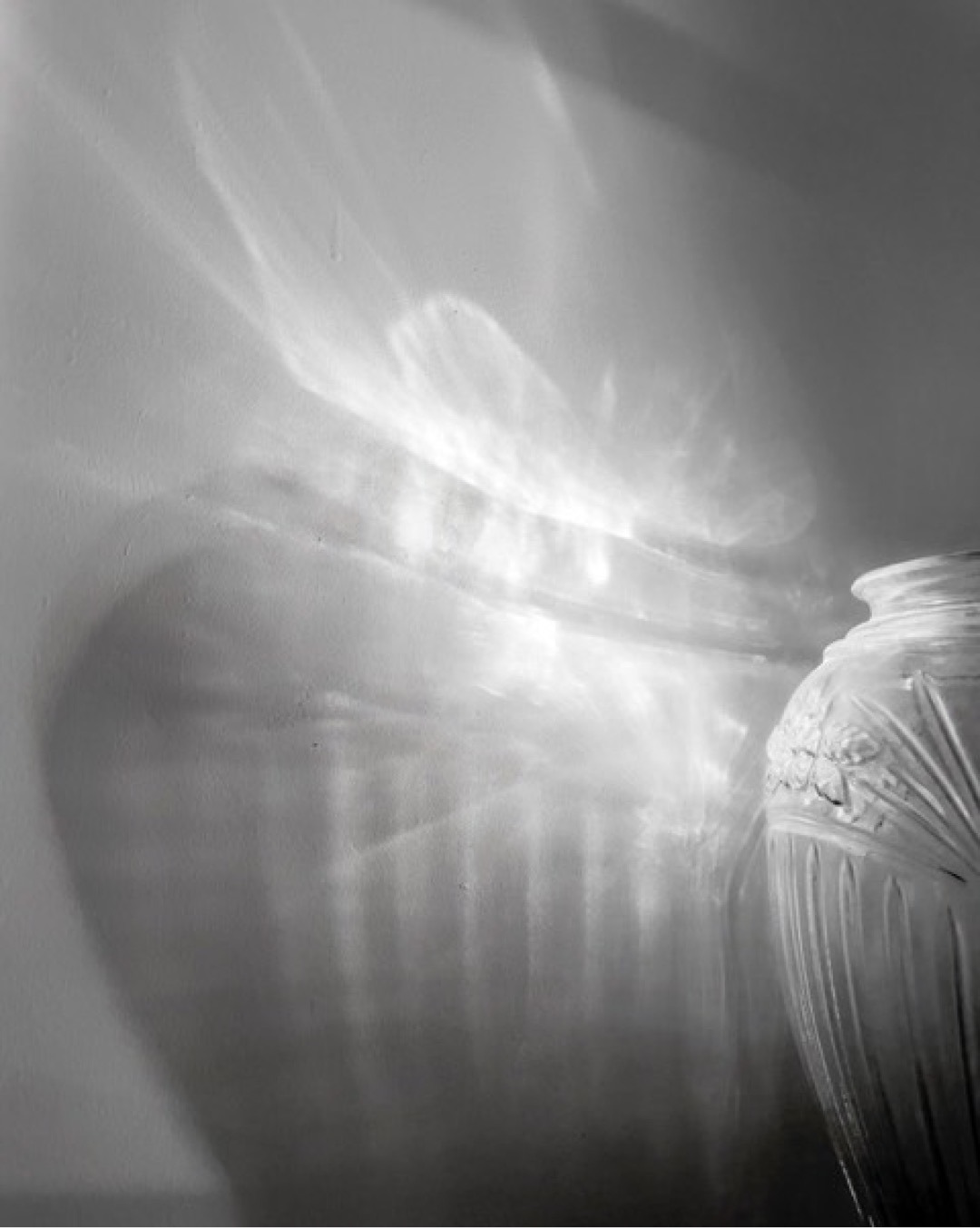
Diane Farris
Local Light
Photograph
April 2023
Local Light is part of an ongoing series of images on light, reflections and shadows. Working close to home in the past few years, I have been taken by the wisdom, sustenance and – often – the unexpected beauty of the close at hand, the local.
This photograph was taken recently, when a burst of unexpected light emanated from a familiar corner. What’s Next for Earth’s current call, Economic Relocalization, emphasizes attention to every possibility in nearby resources, “local economies with deep and ancient roots” (Richard Heinberg, excerpt from the Think Resilience course).
© 2023 Diane Farris
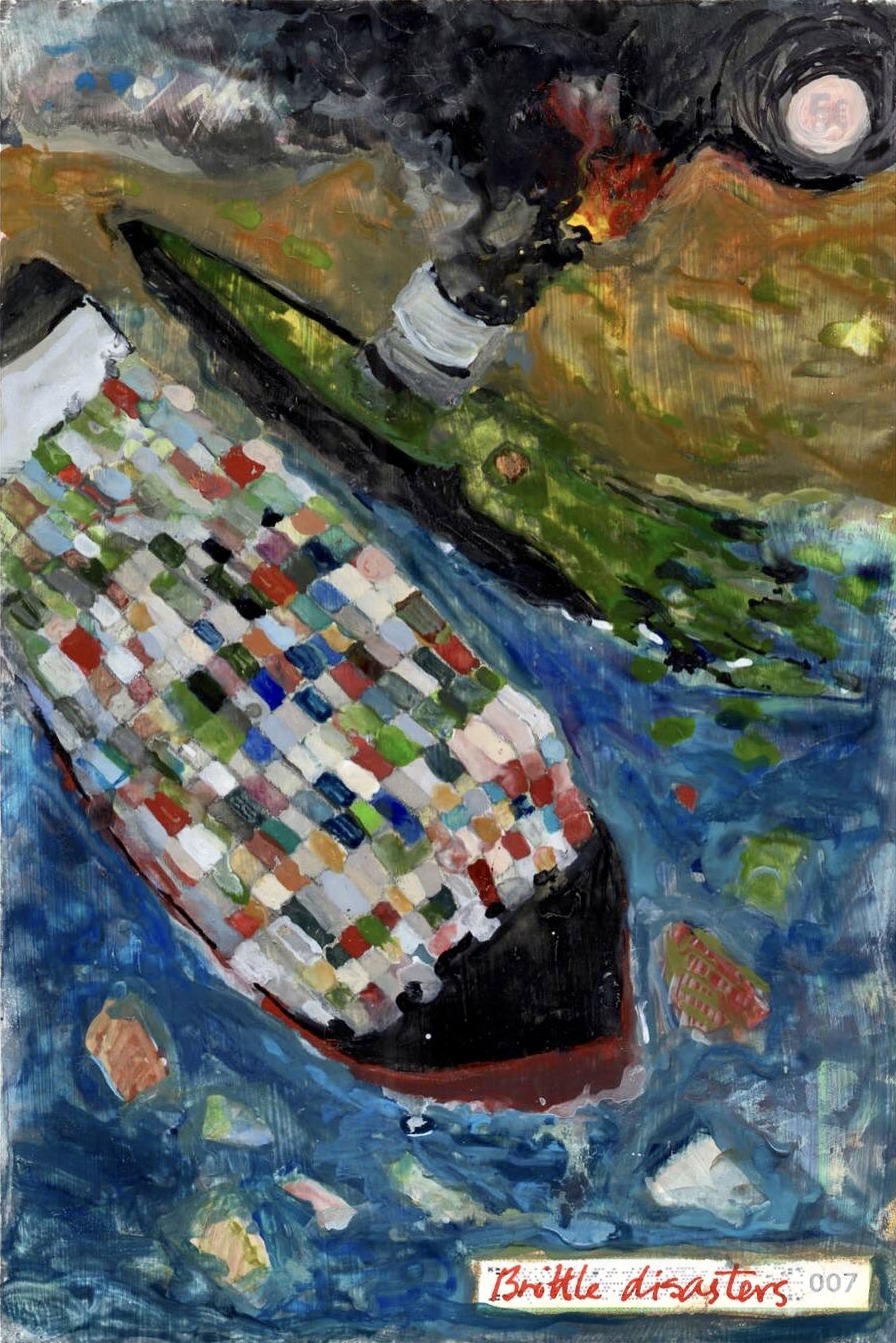
Ries Faison
Concepts I should know: brittle disasters
watercolor and water soluble crayon on found unlucky lottery ticket
6 x 4 inches – 15 x 10 cm
2023
The reliance on global supply chains has created a brittle, less resilient economy, particularly in island nations. Disruptions from climate (floods, hurricanes, heat waves …), political instability (wars, revolutions), and health (covid-19) cause major disruptions to centralized distribution that is reliant on cargo ships that significantly contribute to global climate change and acidification. Shortages in the food supply cause not just hardship but can lead to starvation.
“A more local and therefore more resilient economy is one in which people feel they have more of a stake in production and distribution as well as consumption; one in which they have more knowledge of where their goods come from and what happens to them at the end of their lifecycle.”
Richard Heinberg —Think Resilience from the Post Carbon Institute
When land investment is driven by short-term profit (single-family housing, shopping malls, warehouses, and golf courses), nature conservation and local farms are not valued. Instead, the land becomes brittle as forests are removed, changing local climates and causing desertification.
These paintings are on lottery tickets discarded when they are discovered to be … unlucky. The concept of the lottery is where our problems (economic, climate, personal) will all be erased the moment we get lucky and win a random contest heavily weighted against the individual. We cannot solve our climate crisis by hoping for a miracle, either.
© 2023 Ries Faison
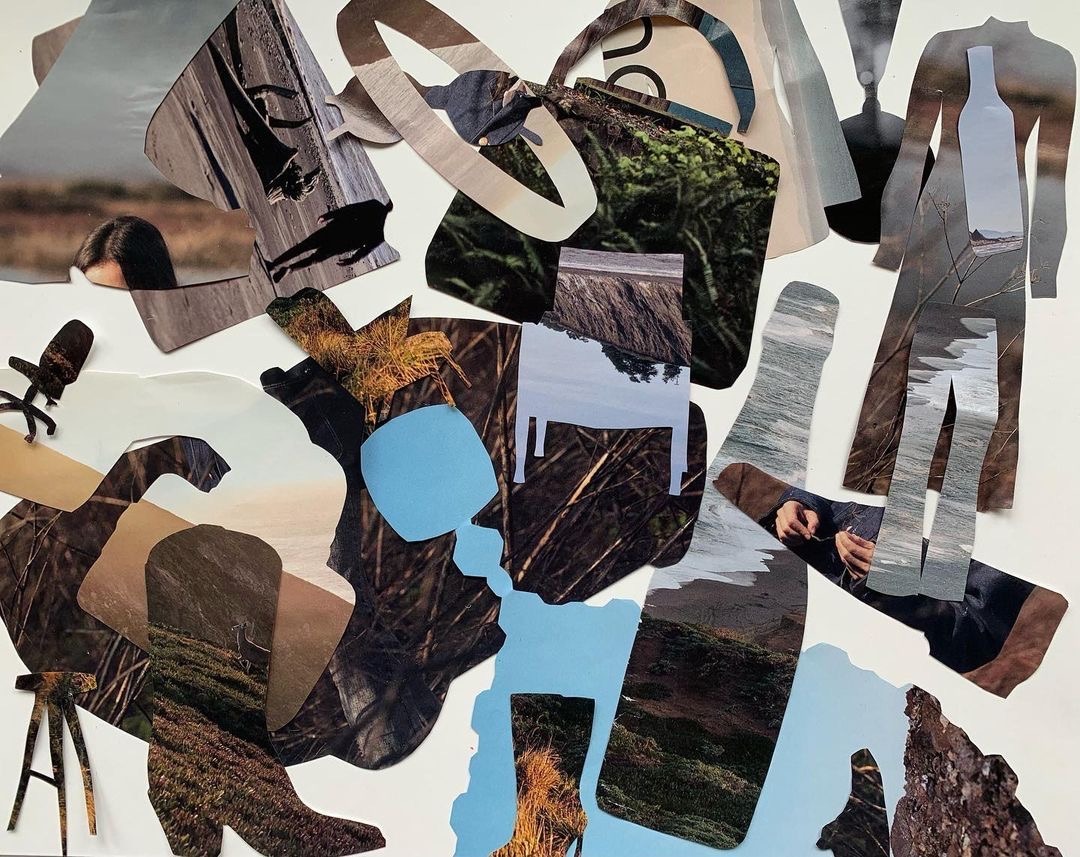
Christina Conklin
Collapse collage: “Economic relocalization”
For this What’s Next For Earth art call, I turned again to the UK’s Financial Times’s glossy magazine, How to Spend It, a paean to self-indulgence at any cost. Recently the mag had a major story about contemporary art in Marin County (of all places!). But it told the wrong story, featuring a small handful of famous and fortunate artists (and their privileged children), rather than the many talented, hardworking, and undersung artists living and working in Marin.
It pissed me off. It is not cool to turn a real place into a postcard, so I decided to cut the stuff (jewelry, cars, fashion) they are selling in HTSI out of the beautiful photos they printed of Marin.
What would it be like if we had to (or chose to) localize our consumption, if our watches and chairs had to come from where we live, without the option of jetting around the world to buy more stuff (including art)? There would be fewer jewels and Jaguars in the world — and all the injustice they require — that’s for damn sure.
© 2023 Christina Conklin
Kim Tanzer
FoodCycles
Short video, comprised of sketches from my visits to a market and a garden
Repetition creates pattern. Pattern is habit. Patterns become teachers.
I have always visited farmers and flea markets when I travel, to sample local cultures. I am similarly drawn to the world’s diverse gardens and farms. Reviewing my photos, I’ve noticed I often make images of multiples. Created by repetitive plants, foods, or recycled goods, these multiples create patterns. Upon reflection, I recognize these patterns as the resultant forms of human actions—accumulated across a season of cultivation, a career of market distribution, or generations of recipes’ production.
I am attracted to the beauty of gardens and markets, but also to the local knowledge they transmit, about growing seasons, regional recipes, local cultures. And, as Richard Heinberg recognizes, food and retail are two major industry sectors where we can redouble our efforts to “relocalize” our economy to combat global climate change.
In this short video, comprised of sketches from my visits to a market and a garden, I have tried to invoke the meditative repetitions of Bill Viola’s videos, Laura Dean’s dances, Godfrey Reggio’s films, Philip Glass’s music, and global traditions of chanting and singing in the round. Cycles beget cycles. Can we celebrate our food cycles as art?
Thank you to Ravi Shankar and Philip Glass for “Offerings” and to the Field & Fork Garden, Gainesville Florida and the Périgeaux Market, Dordogne France.
© 2023 Kim Tanzer
Yvone C. Espinoza
When we are invited
Repurposed costume jewelry, textile, and dried moss on burlap.
10”H x 10”W
Much of my recent work depicts snapshots of community borders. The video clip is an example of an event or many snapshots.
“Relocalization is a strategy to build societies based on the local production of food, energy and goods, and the local development of currency, governance and culture.”—Post Carbon Institute
I heard plenty of music as a child, but one little song from Sesame Street has become a go-to theme on my playlist as I walk through the day encountering folks from all walks of life. “People in the Neighborhood” is a simple little song, but it is a reminder of the value of diversity in the service of community resilience.
Relocalization is more than just an economic strategy. It’s a cultural claiming of the very things that make us all human: a declaration of active, conscious humanity over passive, unconscious conformity. In our very local spaces, under the thin veil of business-as-usual, there is an entire land to understand as more than just a place for strip malls.
We are not alone when we choose to connect with our geography.
Like-minded change agents are farming in fields and on rooftops; they are bringing wildlife back with plants; they are inviting fireflies to appear from piles of branches once again; they are listening to the land. We can hear the hum of the bees. We might spot a lone bald eagle over our own neighborhood. Everything we need is all here.
Yes, business has a role.
Government has a role.
We citizens also have a role.
Citizens create the cultural identity of our geography.
Though it may sometimes seem like we are powerless, together, we truly are the soul of this land.
© 2023 Jodie Atherton
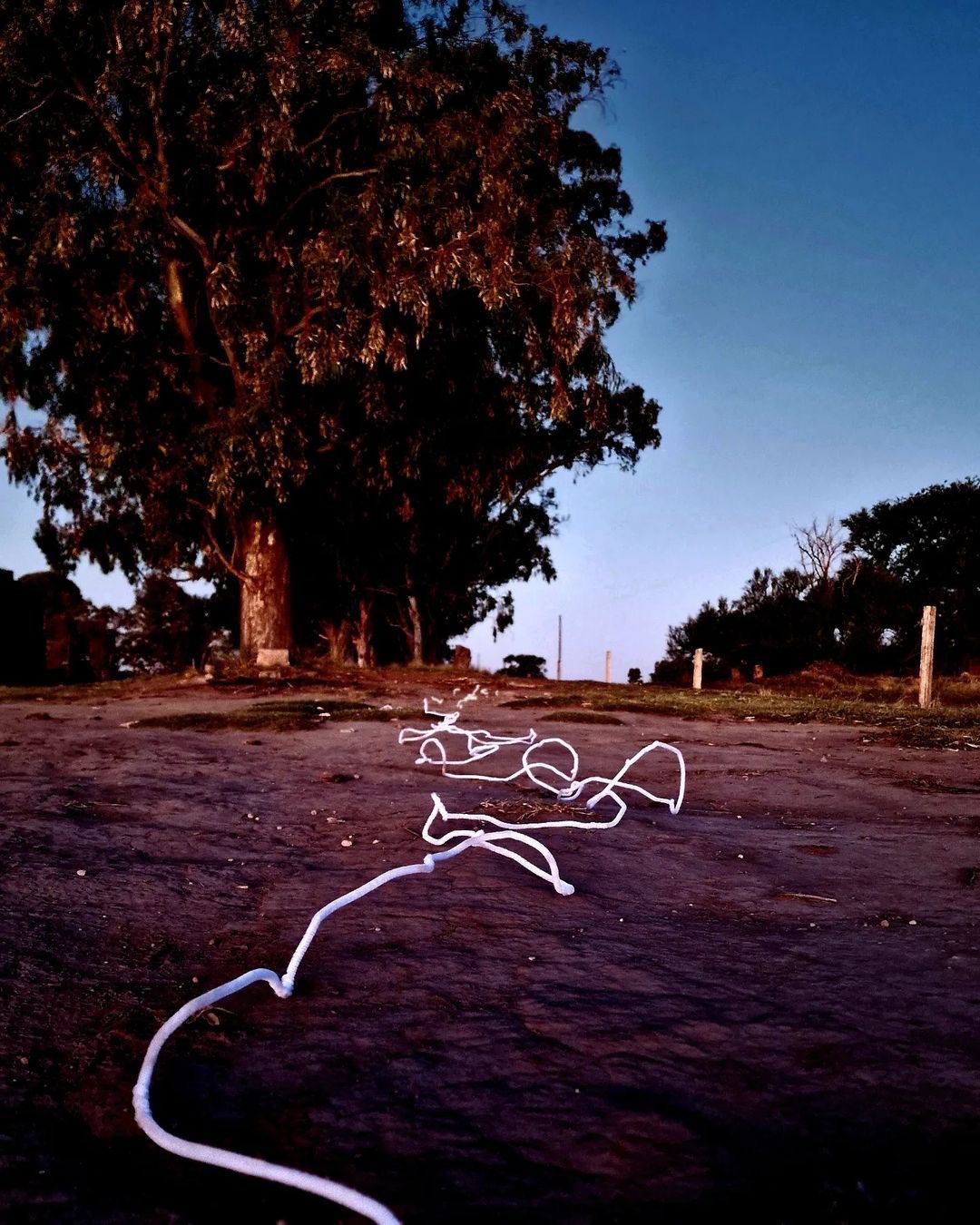
Rosalind Lowry
Earth Day 2023 – The Road Back Home
Drawing made with wire
16 meter long
Location: Ireland
I’ve been part of a Stanford University initiative called What’s Next for Earth for a year now, and this is my contribution to their Relocalization art call. It’s about getting back to using the local economy and supporting local community economics to build resilience against giant corporations. It’s the road back home.
© 2020 Rosalind Lowry
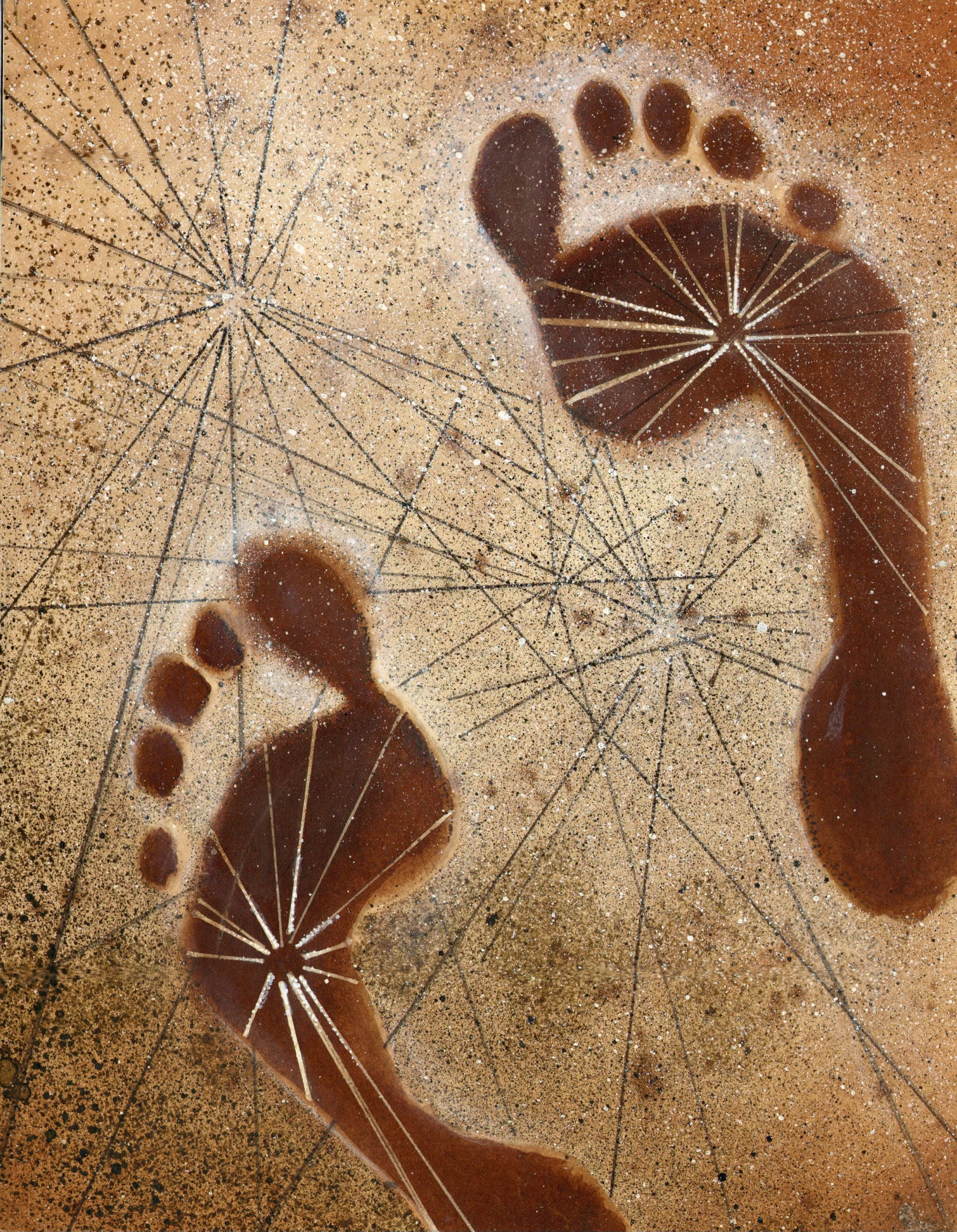
Deborah Kennedy
Support Your Farmer’s Market!
ink on wind-powered bristol paper
81/2” x 11″
Here is a quotation from the Think Resilience online course:
“Local economic development benefits everyone—except maybe big multinational corporations. A more local and, therefore, more resilient economy is one in which people feel they have more of a stake in production and distribution as well as consumption; one in which they have more knowledge of where their goods come from and what happens to them at the end of their lifecycle. Finally, nothing fundamentally new has to be invented for this to 5 | Page © Post Carbon Institute 2017 happen: local economies have deep and ancient roots, and there are already efforts underway in hundreds of towns and cities around the country to support local enterprise.”
© 2023 Deborah Kennedy
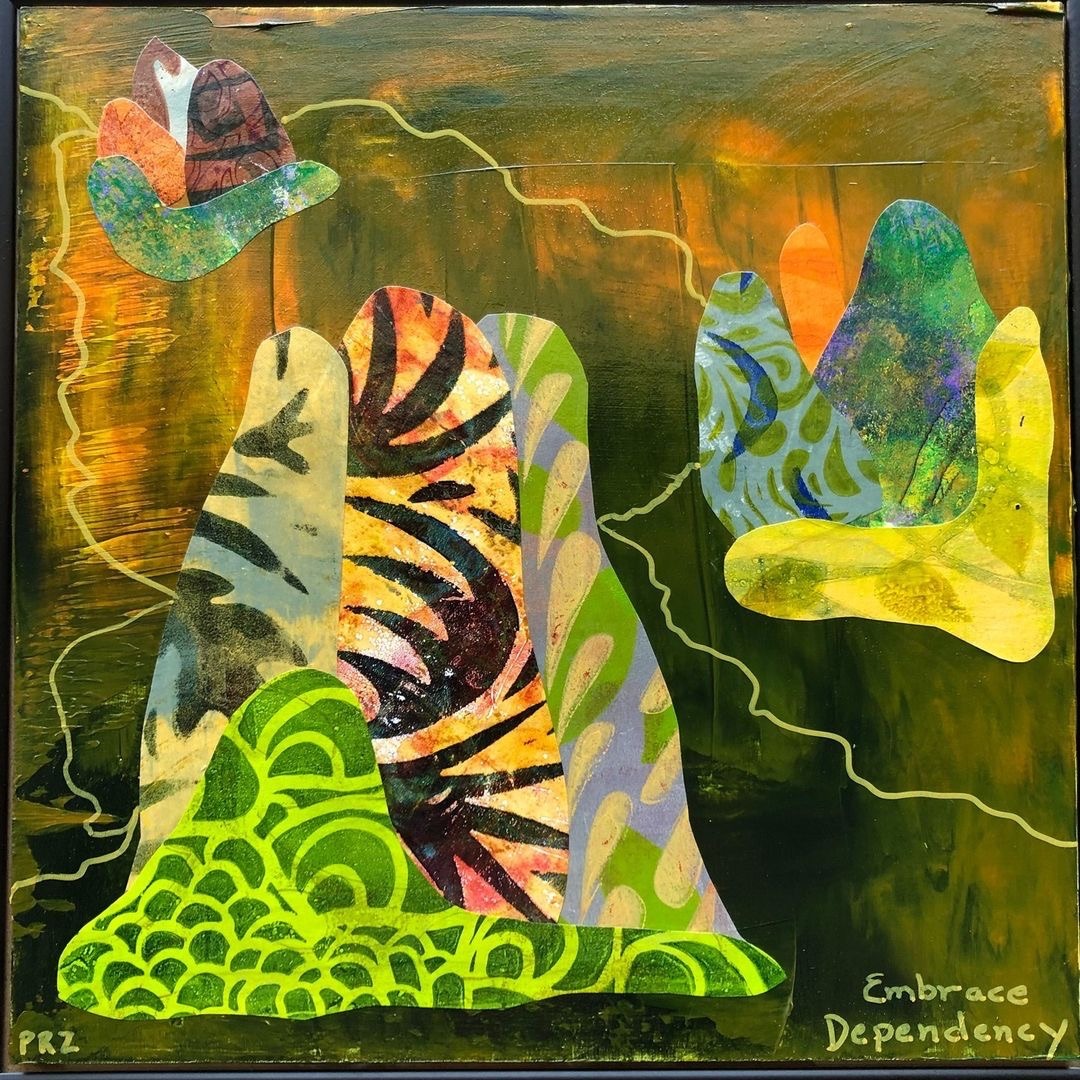
Peggy Rose
Embrace Dependency
Mixed media painting
12”x12”
We see ourselves as independent individuals while, in reality, we depend on global supply chains, global products, global entertainment, etc. We could let this concept of our “independence” go and instead embrace our dependency, on each other, in the place where we are on this earth, with the other beings who are right here sharing it with us.
“Nothing fundamentally new has to be invented for this to happen: local economies have deep and ancient roots, and there are already efforts underway in hundreds of towns and cities around the country”
Richard Heinberg, excerpt from the lesson “Economic Relocalization”, Think Resilience online course, Post Carbon Institute.
© 2023 Peggy Rose
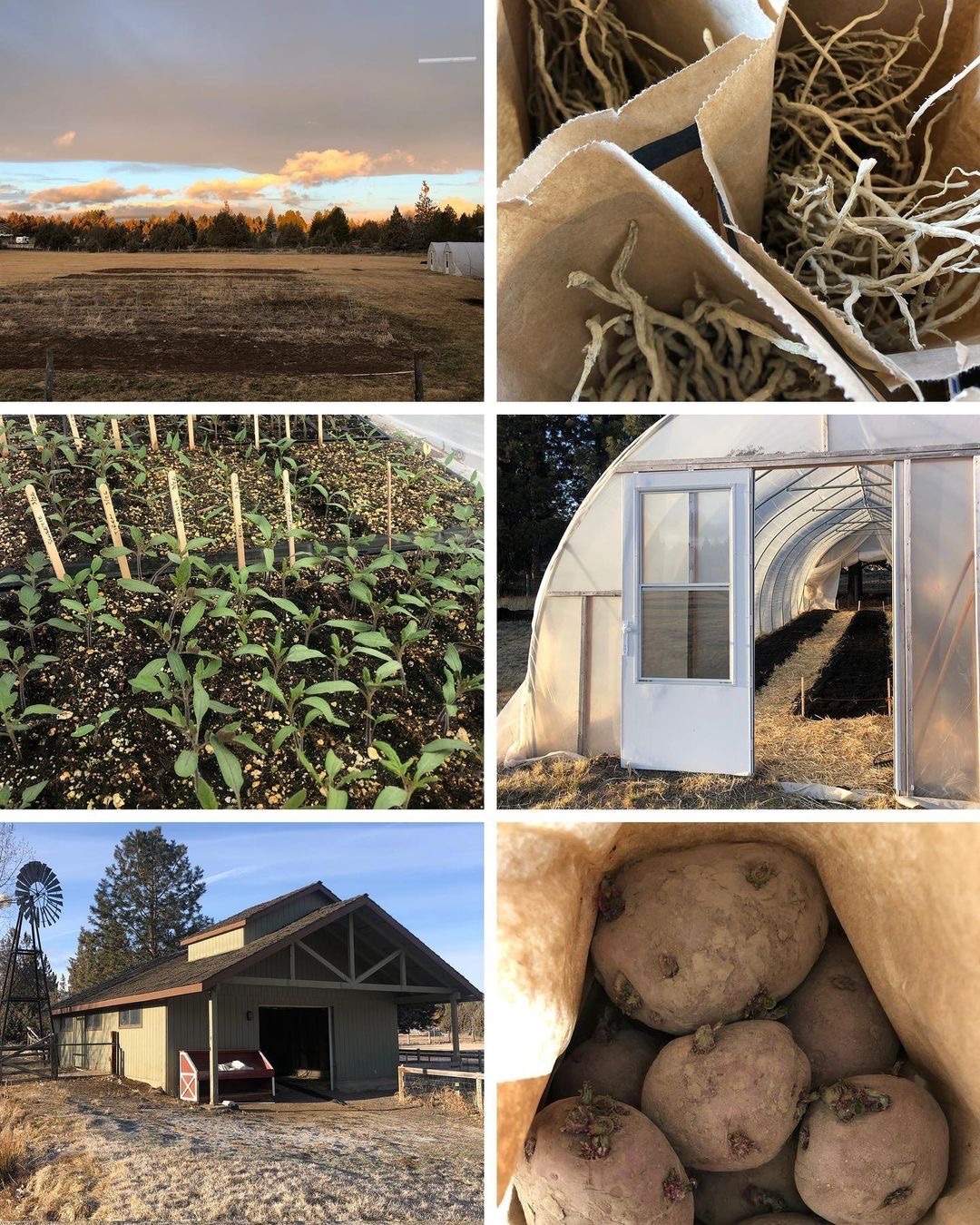
Michele Guieu
Art Farm project in progress
6 photographs
Bend, Oregon, April 2023
Richard Heinberg’s “Think Resilience”, Nate Hagens’ short course on the Human Predicament, and Pablo Servigne’s “How Everything Could Collapse” are just a few examples of the materials that inspired me to shift my focus and pursue new visions for an ever-changing world.
I am thrilled to embark on a new journey with my husband, as we channel our energy towards a small farm and its surrounding community, in Bend, Oregon. Our aim is to establish an art farm, and we have already taken steps to get acquainted with our neighbors, who come from diverse backgrounds and have unique stories. In fact, we organized the first community meeting where we recently had the pleasure of meeting many individuals for the first time.
From top left to bottom right, the photos show: the farm and its hoop houses, asparagus crowns, seedlings, the inside of the hoop house, the Barn -an art studio and farm workspace- will serve as a hub for community events and art workshops, and potatoes that will be planted.
“A more local and therefore more resilient economy is one in which people feel they have more of a stake in production and distribution as well as consumption; one in which they have more knowledge of where their goods come from and what happens to them at the end of their lifecycle.”
–Richard Heinberg, excerpt from the “Economic Relocalization” lesson, Think Resilience course.
© 2023 Michele Guieu
This exhibition is based on Think Resilience, Post Carbon Institute’s free online course. To respond to the art call, we asked the artists to signup and to watch the course, one lesson/video at a time. Each video is approximately 12 minutes long.
[Lesson 1: Introduction to the course]
CHAPTER 1: Our Converging Crises
- Lesson 2 – Energy
- Lesson 3 – Population and Consumption
- Lesson 4 – Depletion
- Lesson 5 – Pollution
CHAPTER 2: The Roots and Results of Our Crises
- Lesson 6 – Social Structure
- Lesson 7 – Belief Systems
- Lesson 8 – Biodiversity
- Lesson 9 – Collapse
CHAPTER 3: Making Change
- Lesson 10 – Thinking in Systems
- Lesson 11 – Shifting Cultural Stories
- Lesson 12 – Culture Change & Neuroscience
CHAPTER 4: Resilience Thinking
- Lesson 13 – What is Resilience?
- Lesson 14 – Community Resilience in the 21st Century
- Lesson 15 – Six Foundations for Building Community Resilience
CHAPTER 5: Economy and Society
- Lesson 16- How Globalization Undermines Resilience
- Lesson 17- Economic Relocalization
- Lesson 18- Social Justice
- Lesson 19- Education
CHAPTER 6: Basic Needs and Functions
- Lesson 20- Meeting Essential Community Needs
- Lesson 21- Resilience in Major Sectors
- Lesson 22- Review, Assessment & Action
Think Resilience is hosted by Richard Heinberg, one of the world’s leading experts on the urgency and challenges of moving society away from fossil fuels.
We live in a time of tremendous political, environmental, and economic upheaval. What should we do? Think Resilience is an online course offered by Post Carbon Institute to help you get started on doing something. It features twenty-two video lectures—about four hours total—by Richard Heinberg, one of the world’s foremost experts on the urgency and challenges of transitioning society away from fossil fuels. Think Resilience is rooted in Post Carbon Institute’s years of work in energy literacy and community resilience. It packs a lot of information into four hours, and by the end of the course you’ll have a good start on two important skills:
1. How to make sense of the complex challenges society now faces. What are the underlying, systemic forces at play? What brought us to this place? Acting without this understanding is like putting a bandage on a life-threatening injury.
2. How to build community resilience. While we must also act in our individual lives and as national and global citizens, building the resilience of our communities is an essential response to the 21st century’s multiple sustainability crises.
What’s Next For Earth is an art project created in March 2020 by Michele Guieu, eco-artist, and MAHB Art Editor, to understand the human predicament and reflect on the ecological emergency to take action. The project is supported by the MAHB and the Post Carbon Institute. If you have any questions, please send your message to michele@mahbonline.org.
Thank you ~

